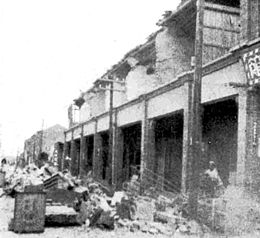User:Taiwantaffy/Quakes/1935 Xinzhu-Taizhong Earthquake
 | |
| UTC time | ?? |
|---|---|
| Magnitude | 7.1 MGR |
| Depth | 3 kilometres (2 mi) |
| Epicenter | 24°18′N 120°45′E / 24.30°N 120.75°E |
| Areas affected | |
| Casualties | c. 3,300 |
The 1935 Xinzhu-Taizhong earthquake (Chinese: 1935年新竹台中地震; pinyin: 1935 nián Xīnzhú-Táizhōng Dìzhèn or Chinese: 1935年中部大地震; pinyin: 1935 Nián Zhōngbù Dà Dìzhèn; literally Great 1935 Central Taiwan Earthquake) was a magnitude 7.1 earthquake which occurred on April 21, 1935, with its epicentre in Miaoli, Taiwan. It was the deadliest earthquake in Taiwan's recorded history, claiming around 3,300 lives and causing extensive damage. 12 seconds after the main quake, an aftershock of ML 6.0 occurred, centred on present-day Emei Township, Xinzhu County.
Technical details
[edit]The initial shock happened at 06:02 local time on April 21, 1935. The epicentre was in Sanyi Township, Miaoli County, with the quake measuring 7.1 on the Richter scale. The quake was felt all over Taiwan apart from Hengchun on the southern tip of the island, as well as in Fuzhou and Xiamen, across the Taiwan Strait.[1] Soil liquefaction was observed in various locations, and a 3m drop between the two sides of the fault was in evidence at Emei Township.[2] The most serious damage from the quake was located in Shinchiku Prefecture and Taichū Prefecture (present-day Miaoli and Taichung County) over a 135km2 area.[1]
A number of aftershocks followed the main quake, with the largest registering 6.0 with an epicentre in Emei Township, Xinzhu County.
Damage
[edit]The earthquake was the deadliest in Taiwan's recorded history. The official reports cite the following figures for deaths, injuries and damage:
- Deaths: 3,276
- Injuries: 12,053
- Houses destroyed: 17,907
- Houses damaged: 36,781
The infrastructure of the island also sustained severe damage, with transportation, communications, and water networks heavily compromised.[3]
Reported portents
[edit]Residents in central Taiwan reported that several days before the earthquake there were "signs in the sky" of impending disaster, while locals from Qingshui, near the epicentre, reported water boiling in ground wells an hour before the shock.[4]
Response
[edit]The great number of casualties in the earthquake prompted a review of safety standards, with the colonial Japanese government implementing building codes of a similar standard to those in force in Japan in the wake of the disaster.[3] Locals were apparently appreciative of the efforts of Japanese policemen in recovering bodies, given local superstitions about touching the dead.[3]
Notes
[edit]- ^ a b Sen & Wu, p. 18.
- ^ "The 1935 Hsinchu-Taichung Earthquake" (in Chinese). Central Weather Bureau. Retrieved 2009-07-21.
- ^ a b c "The historical impact of earthquake damage on Taiwan society and culture". Taiwan Journal. Retrieved 2009-07-21.
- ^ Sen & Wu, p.17
References
[edit]- Sen, Xuanxiong; Wu, Ruiyun (1996). 台灣大地震:1935年中部大震災紀實 (Great Taiwan Earthquake: The 1935 Central Taiwan Earthquake Disaster Report). Taipei, Taiwan: Yuanliu. ISBN 957-32-2793-2.
